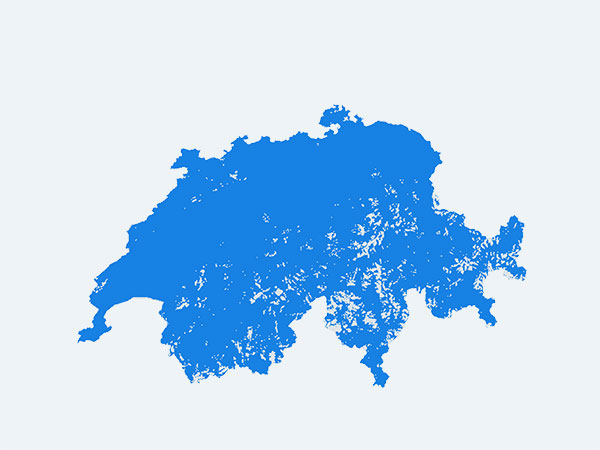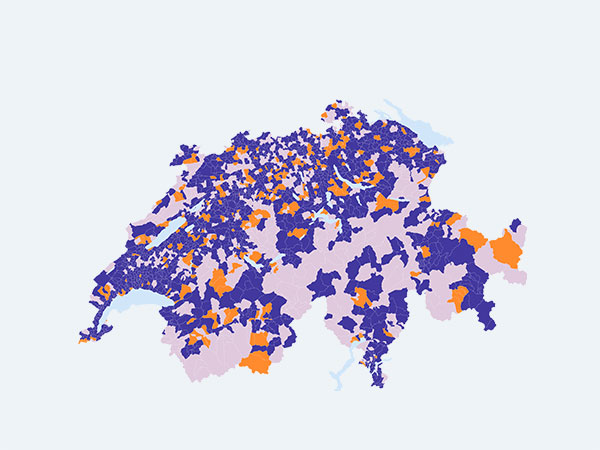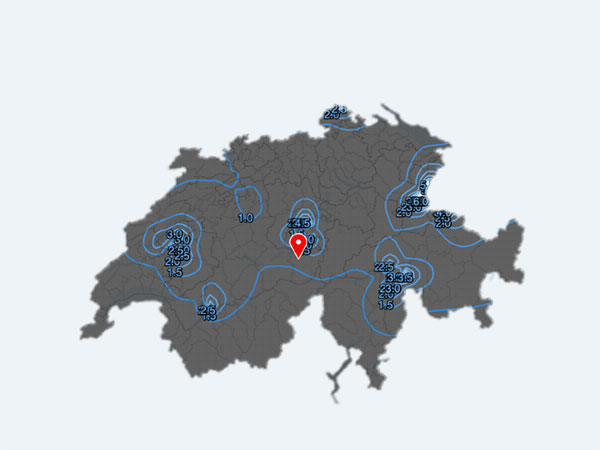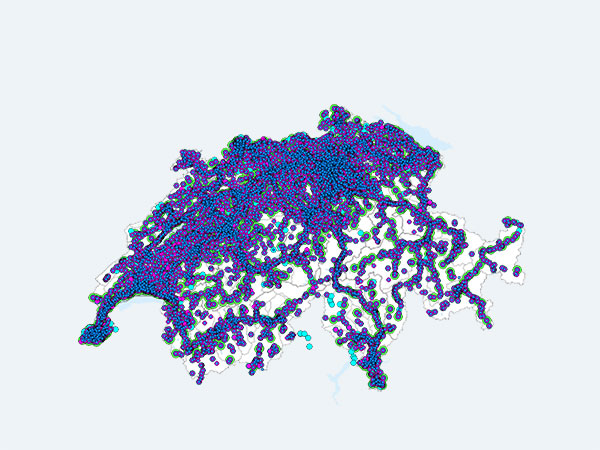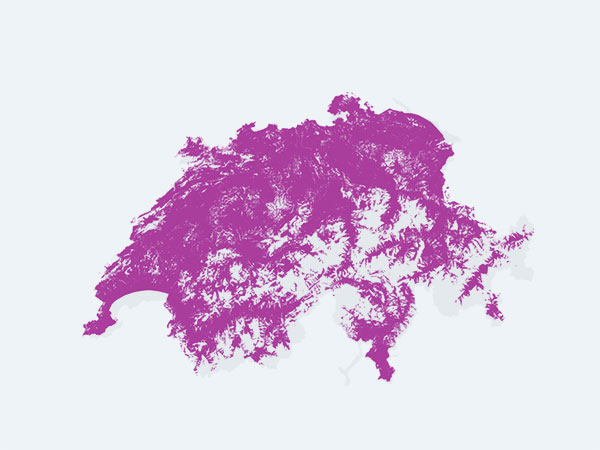The Swisscom network where you are
Experience the Swisscom network through our interactive maps. Find out more about mobile phone coverage, fibre-optic expansion and electrical field strengths for every location in Switzerland.
Overview of fixed network technologies
All IP
All IP is the technology behind a universal network (copper and fibre optics) based on the Internet Protocol (IP). All IP means that all services, such as TV, Internet or even fixed network telephones, run on the same IT network. Telephone calls are transferred in data packets instead of analogue signals, as is already the case for Internet services. Thanks to the universal All IP network, devices and services communicate with each other and share data. In the medium to long term, Swisscom is migrating all existing communication networks to IP so that it can provide all telecommunications services (telephony, data transmission, TV, mobile telephony etc.) across IP. With all the IP services within Switzerland running on Swisscom's own network, it guarantees higher security and availability than other voice service providers on the World Wide Web.
Bandwidth
The bandwidth indicates the transmission capacity of a medium, also known as the download speed. The higher the bandwidth, the more information units (bits) that can be transferred per unit of time (seconds) (bit/s, kbit/s, Mbit/s).
DSL + LTE Bonding
DSL + LTE Bonding bundles the bandwidths of fixed and mobile networks to produce higher speeds for customers. Swisscom has also developed an Internet receiver for 4G (LTE) mobile telephony known as the Internet Booster. This boosts the Internet speed of copper lines with fast 4G mobile Internet, increasing Internet speeds by up to 50 Mbit/s for residential customers, depending on package.
DSL (Digital Subscriber Line)
DSL is the generic term for the transmission technology via subscriber access lines that are made completely or partially from copper. Examples of DSL technologies are ADSL or VDSL.
FTTB – Fibre to the Building
With this technology, fibre-optic cables are installed up to the building. Bandwidths of up to 100 Mbit/s can be used currently. FTTB is mainly used in larger apartment blocks.
FTTC – Fibre to the Curb
For FTTC, Swisscom installs the fibre-optic cables up to the distributor (local exchange or neighbourhood distribution box). Bandwidths of up to 100 Mbit/s can be used currently.
FTTH – Fibre to the Home
FTTH is the end-to-end provision of fibre-optic cable for apartments and businesses instead of traditional copper cable. Swisscom supplies private households with FTTH fibre optics, offering bandwidths of up to 10 Gbit/s.
FTTS – Fibre to the Street
FTTS brings fibre optics to 220 metres from customer homes, taking ultra-fast broadband across the regions. This technology can then be expanded to FTTH. Bandwidths of up to 500 Mbit/s can be used currently.
G.fast
G.fast is a new transmission processes that significantly increases the bandwidths on copper lines compared to VDSL using higher frequencies. With G.fast, up to 500 Mbit/s is possible for FTTS/B; the exact capacity depends on the length and type of cable.
Fibre optics
Fibre-optic cables allow optical data transmission, in contrast to copper cables which use electrical signals to transmit data.
IP (Internet-Protokoll)
IP offers the option of integrating various services into a network: Typical applications are virtual private networks (VPN), telephony (Voice over IP) and faxing (Fax over IP).
PWLAN – Public Wireless Local Area Network
PWLAN is a wireless, local open network. Typical data transfer speeds in PWLAN networks are 5–10 Mbit/s.
Ultra broadband
Ultra broadband represents bandwidths of over 50 Mbit/s – both on the fixed and mobile network.
VDSL (Very High Speed Digital Subscriber Line)
VDSL broadband technology is the fastest DSL technology at present. It provides transfer speeds of up to 100 Mbit/s. VDSL2 is the latest version of VDSL.
VoIP (Voice over Internet Protocol)
VoIP produces telephone lines via the Internet.
Vectoring
Vectoring is a technology used in connection with VDSL2 to eliminate copper-wire interference. It is used to maximise transmission speed (permitting up to a two-fold increase).
WLAN (Wireless Local Area Network)
WLAN is a local wireless radio network. A WLAN links several computers wirelessly with a central information system, a printer or a scanner.
Overview of mobile communications technologies
5G
The latest mobile telephony standard currently offers speeds of up to 2 Gbit/s.
4G+/LTE Advanced
4G+/LTE Advanced enables a theoretical bandwidth of up to 700 Mbit/s on the mobile phone network. Speeds of up to 300 Mbit/s are already available to 90% of the Swiss population and 72% can access speeds of up to 500 Mbit/s.
4G/LTE (Long Term Evolution)
4G/LTE is the successor to 3G technology. It represents the fourth generation of mobile technology. 4G currently enables mobile broadband data rates of up to 150 Mbit/s.
3G
3G is the third generation of mobile technology and includes UMTS, HSPA und HSPA+. 3G enables speeds of up to 42 Mbit/s and covers 99% of the Swiss population.
2G
2G is the second generation of mobile technology that is being phased out by the end of 2020 after more than 25 years. It includes mobile technology such as GPRS, EDGE and GSM.
Carrier aggregation (frequency bundling)
Carrier aggregation is a way of increasing the data rate per user by connecting several frequency blocks together. It means a much larger number of users can use a radio cell simultaneously with higher speeds.
EDGE (Enhanced Data Rates for GSM Evolution)
EDGE is a feature of the second mobile technology generation and is being phased out by the end of 2020 after more than 25 years. EDGE enables data transfer speeds of up to 256 kbit/s.
GPRS
La rete GPRS appartiene alla seconda generazione di telefonia mobile e sarà disattivata entro la fine del 2020, dopo più di 25 anni di servizio. Sulla GPRS era possibile raggiungere velocità di trasmissione da 30 a 40 kbit/s.
GSM-Netz (Global System for Mobile Communications)
GSM is a global digital mobile telephony standard within the second mobile technology generation and is being phased out by the end of 2020 after more than 25 years. As well as voice and data transmission, it supported services such as SMS and international roaming.
HSPA (High Speed Packet Access)
HSPA is a further development of the UMTS mobile telephony standard. HSPA allows a much greater number of customers than was possible with UMTS to use a radio cell at the same time and at a constantly high speed. A transfer rate of up to 14.4 Mbit/s is supported by HSPA.
HSPA+
HSPA+, also known as HSPA Evolution, is the expansion of HSPA for locations experiencing regularly high customer demand. Each radio cell offers a transmission capacity of up to 21 Mbit/s.
UMTS (Universal Mobile Telecommunications System)
UMTS is a third-generation international mobile telephony standard that combines mobile multimedia and voice services. Speeds of up to 384 kbit/s are possible with UMTS.
Field strengths
Our map shows the electrical field strength in volts per meter as usual. However, this field strength does not reflect the measurement data on site; it is automatically calculated from the output data of the masts under review and the selected terrain point. A daily mean value and plant utilisation are also included. The result is a realistic daily average. This should not be confused with the theoretical maximum value that must be stated in the location data sheets for the mobile communication installation.
Low Power Network (LPN) LoRaWAN
The network for your IoT applications. It cuts your devices’ energy usage and is ideal for transferring small quantities of data. The Swisscom LPN already covers more than 97.2% of the Swiss population.
